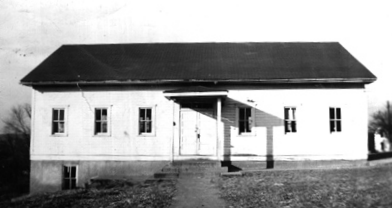
Old 2-Room School
Contributed by Becky Millinger
|
The first settler in the area which would later be known as Victoria, Missouri, was Thomas L. Bevis. For decades, this town of nearly 200 years has been slipping away...sadly, the story of many small communities in rural Missouri left to die in areas where a once bustling town thrived. Such is the story of Victoria.
Thomas Bevis founded this small town in
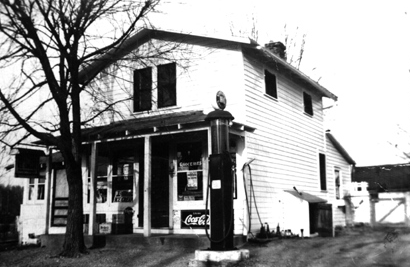
Goades' Grocery Store
Contributed by Becky Millinger
|
1802 after the Spanish government granted him 502 acres. Bevis’ wife, Prudence Bevis, was the notable one in the family though; she was better known in the community as “Queen Bevers”, a witch who tormented her neighbors and who was blamed for every misfortune known to the town. According to St. Louis Post-Dispatch writer, Jeremy Kohler, in an article about the town's famous resident, no one remembered the meaning of the name or why the spelling was changed. Many of the old Victoria residents were able to recall many a tale of the beautiful Irish woman who reveled in her reputation as a witch. More about her later.
While the area was still backwoods, early travelers came to the area to do business

Pinson's Store
Contributed by Becky Millinger
|
in Hillsboro, four miles north of Victoria, by foot, on horseback, by farm wagon or buckboard. The first stage coach began running in the late 1830s and with the coming of the railroad brought the height of the town's activity. The St. Louis and Iron Mountain Railroad was extended through Victoria in 1858. With the railroad came prosperity. A hotel, The Victoria House, was built just a walk from the railroad tracks, a large two story building that gave respite to weary travelers. The town grew under the activity of the trains which brought people into the area but also expanded the wallets of farmers whose agricultural products were shipped out to nearby St. Louis. In the 20th century, Victoria was home to a depot, a two-room schoolhouse, one of the county’s busiest post offices,
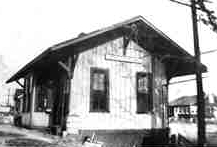
Railway Depot
Contributed by Becky Millinger
|
two grocery stores and a church. After the closing of the school which incorporated children into the Hillsboro and DeSoto Public Schools and the post office, the town was left to its few residents and the church.
The Victoria Church was organized on January 17, 1914. History has that the church was shared by the Methodist and Baptists of the area, alternating occupation of the building every other week. Outside the town in the Victoria Cemetery which was dedicated to Victoria residents during the Civil War. The railroad was the circle of all activity in this area of Jefferson County. Passengers coming from St. Louis included lawyers and judges who would travel on to Hillsboro to hold court. Prisoners were transported in chains on the train and taken on to the jail in Hillsboro. The Victoria House prospered, serving many meals and boarding visitors to the area.
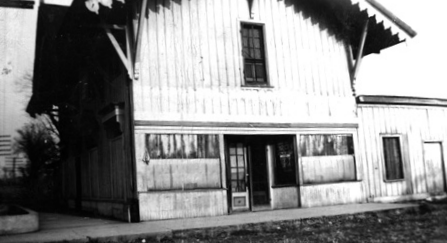
Victoria House Hotel
Contributed by Becky Millinger
|
As stated before, not all the activity was coming into town. Farmers brought their wagons to the trains at dawn to ship their produce and dairy products. Victoria was known for having the best produce shipping point in the county in the late 1800s. Stagecoaches made four trips a day between Victoria and Hillsboro. Dairy farmers would travel to the freight depot before the sun was up in order to get their products to the market. My mother, Anna DeGonia Williams, remembers during the war when my grandfather worked in Weldon Springs at the small arms factory during the week, she and my grandmother would milk their dairy cattle, process the milk and take it by cart to the train stop. She would then go home to get herself and her younger siblings dressed for school. Other tales told by my mother include stealing watermelons from the family garden and innocently suggesting to grandma that the railroad bums must have taken them. According to my mom, many of these "bums" came to the back door for a hot meal and the kindness extended by my grandmother. "She never let them into the house, but they must have spread the word because they were always there at dinnertime."
Near the Victoria Bridge is an old tree that I’m tempted to look for,
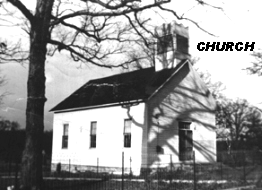
Church in Victoria
Contributed by Becky Millinger
|
to see if the cable that was strung there by my uncles and mother is still there. The cable had a rope tied to it and after climbing the tree it could be pulled up the branch where a jump into the abyss would swing you well out over and into the water. Caution was thrown to the wind when during an afternoon swim, hunger pangs taunted them to eat green apples. Grandpa made sorghum molasses from cane grown on his land. Mom and her brothers would use two knives to shuck the leaves off and cut a strip down the sides of the cane and grandpa had a press to extract the raw juice. A mule walked around in circles to power the press where vats caught the juice which would be cooked down to produce the molasses. All the neighbor kids would come to stick their fingers in the molasses for a taste and it was bottled and sold for one dollar a gallon.
Getting back to the tale of Queen Bevers, for 28 years after Thomas Bevis’ death in 1826, most of the misfortunes of the little town were blamed on Prudence. She apparently enjoyed her reputation as a witch and did not do much to dispel the rumors about her. One rumor that was told was that she had turned fellow townsman, Aaron Cook into a horse and had ridden him to a ball. What seems particularly to have annoyed him is that she left him tied to a plum bush.
Another tale was one of a family of girls who became sick with a strange disease which was, of course,
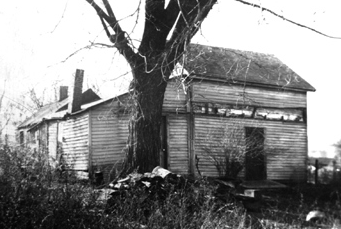
The Gualt House
Oldest house in Victoria
Contributed by Becky Millinger
| blamed on Queen Bevers. A witch doctor was found in one of Missouri’s lower counties (from an article in Missouri Historical Review) and the witch doctor on examining the girls found a hairball in a boil on one of the girl’s limbs. He procured a remedy and the girl was cured. Queen Bevers was said to have always tried to be present at the birth of a child in the town. Once, when the Joachim Creek was at flood stage she supposedly sat astride a bull and swam across to see the child. (St. Louis Post article) Local residents have claimed to have contacted Prudence Bevis by using an Ouija board and as the story goes, she demanded to not be called Queen Bevers and claimed that she had been murdered.
The coming of highways, truck shipment of produce and dairy products and progress sealed the fate of the small out-of-the-way community of Victoria, Missouri. Most of its residents are retired, living in houses long-ago paid for. Other nearby communities closer to the highways attract new residents but not the sleepy little town of Victoria. As with many of Missouri’s tiny historical communities, there are still tales to be told of the glory days and people who remember...with a sigh...how it used to be.
Return to City of the Month Main page
|


